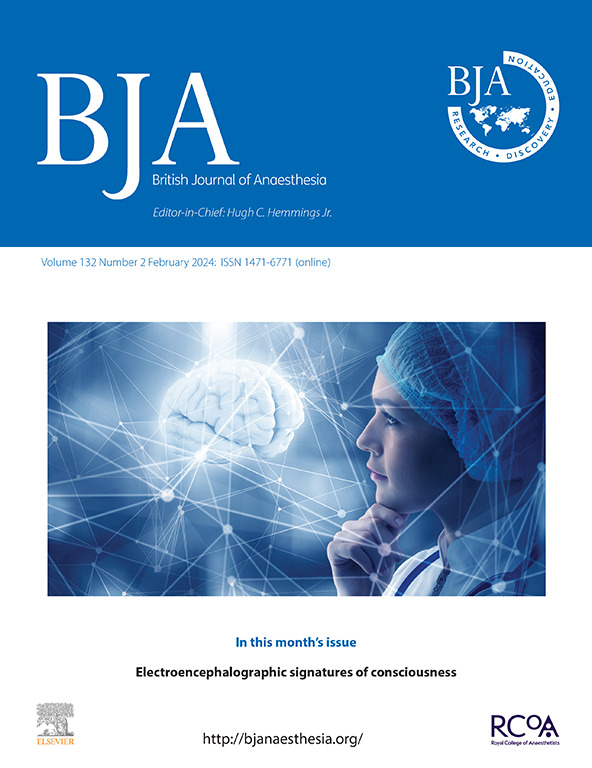Effects of a national team training intervention for operating theatre teams on patient and staff outcomes: a stepped-wedge cluster-randomised trial and mixed-methods study.
IF 9.1
1区 医学
Q1 ANESTHESIOLOGY
引用次数: 0
Abstract
BACKGROUND We evaluated a national, multidisciplinary in situ simulation-based team training intervention in New Zealand public hospitals. We hypothesised that outcomes for surgical patients and staff perceptions of teamwork and observed teamwork behaviours would improve after the intervention. METHODS In a stepped-wedge cluster trial, all New Zealand's 20 District Health Boards were semi-randomised into four cohorts. Training was progressively implemented with one cohort per year. Patient outcomes were derived from a national administrative dataset. Outcome measures were intervention uptake, days alive and out of hospital at 90 days (DAOH90), pre-post staff Teamwork Perceptions Survey scores, and pre-post measures of observed teamwork performance during administration of the World Health Organisation Surgical Safety Checklist. RESULTS Nineteen District Health Boards implemented training, and 41% of the estimated 3800 eligible staff participated. Post-intervention, DAOH90 increased 0.12 days (n=436 785 surgical cases) but we could not separate the intervention's effect from other temporal factors. Teamwork Perceptions Survey scores improved by 0.35 (95% confidence interval, 0.10-0.59) (P=0.006), 0.37 (0.12-0.63) (P=0.006), and 0.50 (0.22-0.78) (P<0.001) on a 5-point scale for 'Overall', 'Communication and Shared Mental Model', and 'Trust and Accountability', respectively. There was no important effect on observed teamwork. CONCLUSIONS We achieved small improvements in teamwork by involving 41% of New Zealand operating theatre staff in team training. Improved patient outcomes could not be solely attributed to our intervention, potentially reflecting high baseline levels of teamwork and surgical outcomes, diluting effects of the progressive uptake of the team training over intervention periods, and other confounders including the COVID-19 pandemic. CLINICAL TRIAL REGISTRATION ACTRN12617000017325.国家团队对手术室团队的培训干预对患者和工作人员结果的影响:一项楔步聚类随机试验和混合方法研究。
背景:我们在新西兰公立医院评估了一项全国性的、多学科的、基于现场模拟的团队培训干预。我们假设手术患者和工作人员对团队合作的感知以及观察到的团队合作行为的结果在干预后会有所改善。方法在一项楔形聚类试验中,新西兰所有20个地区卫生委员会被半随机分为4个队列。培训逐步实施,每年有一个队列。患者结果来源于国家管理数据集。结果测量包括干预的接受情况、90天的存活天数和出院天数(DAOH90)、工作前员工团队合作感知调查得分,以及在执行世界卫生组织手术安全清单期间观察到的团队合作绩效的工作前测量。结果19个区卫生局实施了培训,约3800名合格工作人员中有41%参加了培训。干预后,DAOH90升高0.12天(n= 436785例),但我们不能将干预的影响与其他时间因素分开。在“整体”、“沟通和共享心理模型”和“信任和责任”的5分制量表上,团队合作感知调查得分分别提高了0.35(95%置信区间,0.10-0.59)(P=0.006)、0.37 (0.12-0.63)(P=0.006)和0.50 (0.22-0.78)(P<0.001)。对观察到的团队合作没有重要影响。结论新西兰41%的手术室员工参加了团队培训,团队合作取得了一定的成效。患者预后的改善不能完全归功于我们的干预,这可能反映了高基线水平的团队合作和手术结果,在干预期间逐步接受团队培训的影响被稀释,以及其他混杂因素,包括COVID-19大流行。临床试验注册actrn12617000017325。
本文章由计算机程序翻译,如有差异,请以英文原文为准。
求助全文
约1分钟内获得全文
求助全文
来源期刊
CiteScore
13.50
自引率
7.10%
发文量
488
审稿时长
27 days
期刊介绍:
The British Journal of Anaesthesia (BJA) is a prestigious publication that covers a wide range of topics in anaesthesia, critical care medicine, pain medicine, and perioperative medicine. It aims to disseminate high-impact original research, spanning fundamental, translational, and clinical sciences, as well as clinical practice, technology, education, and training. Additionally, the journal features review articles, notable case reports, correspondence, and special articles that appeal to a broader audience.
The BJA is proudly associated with The Royal College of Anaesthetists, The College of Anaesthesiologists of Ireland, and The Hong Kong College of Anaesthesiologists. This partnership provides members of these esteemed institutions with access to not only the BJA but also its sister publication, BJA Education. It is essential to note that both journals maintain their editorial independence.
Overall, the BJA offers a diverse and comprehensive platform for anaesthetists, critical care physicians, pain specialists, and perioperative medicine practitioners to contribute and stay updated with the latest advancements in their respective fields.

 求助内容:
求助内容: 应助结果提醒方式:
应助结果提醒方式:


